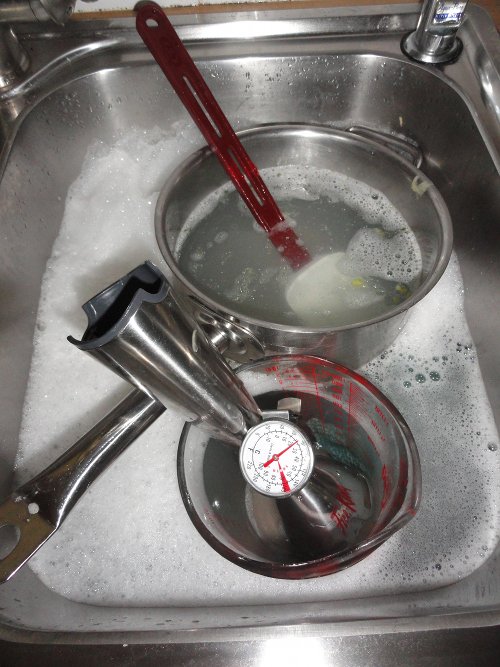I made soap again yesterday and it has given me a chance to reply to an email inquiry I had about a month ago. Jenine asked: "I was just wondering if maybe you could post or even just advise me on clean up after making the soap. I was a bit paranoid of making some chemical reaction from putting the bowl that had the lye in it, in the washing up water, or if there will be any reaction from washing the mixing bowl that I mixed the solution in with any other crockery or cutlery. I just washed everything in hot soapy water? I would appreciate any advise you could give me."
Firstly, as you're making the soap, when you pour the caustic/lye water into the oils, take 30 seconds to rinse out the measuring jug. You don't want to leave a jug that has traces of caustic soda/lye in it. Just a quick rinse will fix that. Also, before you start making soap, pour some cleaning vinegar onto a rag and leave it handy. If you spill or splash any caustic soda/lye, or any raw soap, just wipe it up with the vinegar rag.
When you're filling the soap moulds, make sure you use a spatula and scrape all the soap out of your mixing pot or bowl. Scrape off the mixer, spoons and jugs too. In fact anything that has been used in the soap making process should be scraped or wiped clean before washing so not too much raw soap goes down the drain.
Clean up straight away before the soap goes hard. If you need to use a cloth to clean up, such as around the blades of the mixer, use a rag. Let the rag sit for 24 hours to make sure the soap on it has cured a bit, and add it to the washing machine in your normal wash. When it's clean and dry, it can be used again just like any other rag.
I wash up by hand, so I scrape off everything I can, then fill the sink with hot water and add a good squirt of dishwashing liquid. The raw soap is fairly greasy at this point so you'll need to use a bit more than your usual amount of dishwashing liquid to cut through the grease. Add ½ cup of cleaning vinegar to the water to help neutralise the caustic soda/lye in the raw soap. There won't be much if you've been careful along the way but the vinegar will also help the water drain away well through the drain pipes. Clean everything thoroughly, carefully removing all traces of soap and rinse well. Then let it all dry on the dish drainer.
If you use a dishwasher, scrape and wipe off all the bowls, jugs and utensils, and place them in the dishwasher on a normal cycle.
One of the ways in which we can simplify our lives is to refuse to be sucked into buying new bits and pieces. Soap making is no exception. There is no need to buy a set of mixing bowls or a new mixer just for soap making. If you thoroughly clean every thing afterwards, whatever you use in your kitchen can be used for soap making too. You're cleaning raw soap off the bowls and mixer, not anything more sinister. Stainless steel and glass don't absorb anything. A good clean is all it needs and if you're unsure about the caustic soda/lye, add vinegar to your cleaning routine to neutralise it.
The baby chicks are due to hatch today! I didn't candle the eggs half way through so I'm not sure what to expect. I will be waiting with camera ready.


